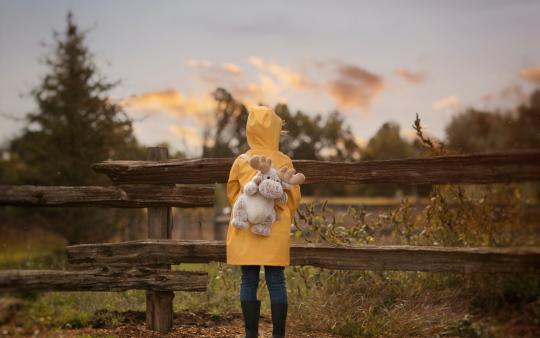Increasing interest in nature-based therapy or eco-therapy is linked to the "eco" movement, a rekindling of bonds with nature, and to the encouraging results being reported in research journals and books like Your Brain on Nature by Eva Selhub and Alan Logan. Find out why eco-therapy may be the perfect approach for your child.
Following nature's path to wellness
Few practitioners can claim to work in an “office” consisting of 45-acres of forest and wetlands. Milton, Ontario child and family therapist Michelle Brans is the exception. While dealing with her own postpartum depression, Michelle discovered that going outside and counting the butterflies on her butterfly bush maximized her own mindfulness practice, far exceeding what she could achieve indoors. This personal breakthrough inspired the name of her business—Counting Butterflies—and has been a way for her to take lessons from her personal journey and use them to benefit others.
Among many therapeutic approaches offered through her clinic, uses this natural setting to focus on children with executive functioning deficits – impairments in planning, problem solving, organizing, impulse control, and self-regulation – often seen in children with Autism Spectrum Disorder (ASD) and Attention Deficit Hyperactivity Disorder (ADHD). She finds nature an effective means of motivating therapeutic interaction and communication for children with anxiety, anger issues, depression, and obsessive-compulsive disorders. Michelle says that offering therapy sessions in a natural environment allows for a more relaxed, client-centered, and play-based approach.
“It’s not like visiting a doctor’s office which can make a child feel like something is wrong and must be fixed... For example, I will take a child out to the large pond just outside the office, and watch how they explore and interact with nature... for a child with difficulty controlling impulses, we will use visits to the pond to practice 'sitting' with inner urges and focusing through distractions."
Forest bathing for mental health
The connection between good mental health and natural settings has long been known. The Japanese even have a term for it: shinrin-yoku (“taking in the forest air,” or “forest bathing”). Simply viewing scenes from nature can reduce cortisol (the stress hormone) levels, blood pressure, and heart rate and increase activity in the areas of the brain associated with empathy and altruism – the same areas that are more active when we are emotionally stable or expressing a positive outlook.
There is encouraging evidence that nature-based psychology has scientific merit. One study found that depressive patients who underwent therapy in a forest setting, compared to hospital-based and community-based counterparts, displayed the most significantly reduced symptoms, cortisol levels, and the highest remission rates. The study concluded that the therapeutic setting played an important part in healing.
Many people would agree that even a simple walk in the woods can have a calming, refreshing effect – what psychologists refer to as Attention Restoration Theory, which compares the voluntary and involuntary brain activity occurring while you interact with your surroundings. When you are navigating a busy city sidewalk during rush hour or when you are entranced by video game images it requires your directed attention, which fatigues the brain and inhibits its ability to function at an optimal level. However, with time spent in natural surroundings that require less voluntary attention, the brain will rest and recover, allowing you to return to other tasks with an increased ability to focus and perform optimally. No less stimulating, connecting with nature provides a kind of involuntary stimulation, meaning the brain is engaged effortlessly and responds to stimuli like the feeling of long grasses against your legs or the sight of the warm glow of a sunset.
Expanding nature therapy with animals
With an understanding of this effect, Michelle uses traditional practices for autism, ADHD, and anxiety, and bridges them with eco-therapeutic activities, having found that it is much easier for children to self-regulate in natural environments like a forest. She complements her nature-based repertoire with animals, especially her golden retriever, Chase. When a child is nervous about talking to Michelle she often encourages the child to talk to Chase instead.
“Dogs are non-judging creatures and Chase will respond to children, but in a non-direct way. I find that just having him present gets kids to be a lot more able to interact with me by putting them at ease.”
Michelle also uses horses to assist with children who have behavioural and self-regulation challenges.
“Horses very much mirror anything that is going on for a client. If a child who has impulse control issues runs towards a horse, as they are often motivated to do, the horse will run away from them... I use that as a motivation tool to get kids to do problem solving and self-regulate themselves... To interact with the horse a child must use their executive functioning.”
Both Chase and the horses help Michelle facilitate mindfulness, the practice of being more present in the moment and being more self-compassionate about the thoughts and emotions that are coming into your mind – all directly linked to the executive functioning component of the brain.
"Neurobiological studies have been pouring in over the past 10 years that have shown that mindful attention can greatly benefit the children I see in my practice. Whether it be nature or animals, any tool I can use to help children to be more present and focused is helping me to get their brains firing in all the right places!"
Many therapists, psychologists, coaches, and social workers are certified in ecotherapy methods or employ opportunities to reach their clients in natural settings. If your child needs developmental, cognitive, or mental health support, ask your referring doctor to help you find a therapist who is versed in this effective style of counseling.






